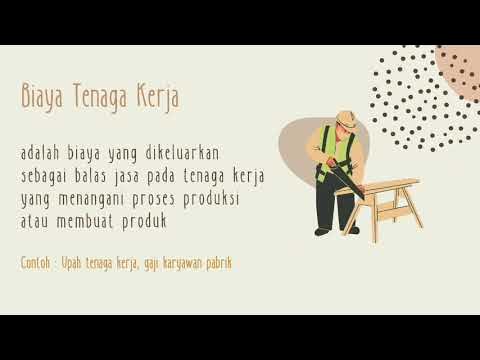Menghitung Harga Pokok Produksi | Kewirausahaan Kelas 10
Summary
TLDRIn this lesson, Ibu Fajriah explains the concept of calculating the cost of production, which includes understanding the total production costs such as raw material, labor, and factory overhead. She also covers how to calculate the cost per product by dividing total production costs by the number of units produced. Additionally, the video discusses how to determine the selling price by adding desired profit margins. The difference between variable costing and full costing methods is also explained, with variable costing only including raw material costs, while full costing includes all production costs.
Takeaways
- 😀 The cost of production, or 'Harga Pokok Produksi', is the price of the raw materials and labor needed to produce a product.
- 😀 Determining the selling price of a product involves understanding its production cost first.
- 😀 The production cost is composed of three main categories: raw materials cost, labor cost, and factory overhead cost.
- 😀 Raw materials are divided into two types: primary materials (e.g., fabric for making masks) and auxiliary materials (e.g., thread for stitching).
- 😀 Labor cost is categorized into wages and salaries.
- 😀 Factory overhead cost includes all other production-related expenses like transportation, electricity, and marketing.
- 😀 To calculate the cost per product, total production costs are divided by the number of units produced.
- 😀 For example, if production costs amount to Rp60,000 and 10 units are produced, the cost per unit is Rp6,000.
- 😀 To determine the selling price, a desired profit margin is added to the production cost. The profit margin can be calculated based on a percentage of the production cost.
- 😀 Another method to determine the selling price is to use the profit margin, which is calculated by adding the desired percentage of profit to 100% and multiplying by the production cost.
- 😀 There are two methods to determine production costs: variable costing, which includes only raw material costs, and full costing, which includes raw materials, labor, and overhead costs.
Q & A
What is the definition of cost of production in the video?
-The cost of production, as explained in the video, is the price or cost of the raw materials, labor, and overhead expenses required to produce a product.
What are the main components of production costs?
-The main components of production costs are raw material costs, labor costs, and factory overhead costs.
What is the difference between raw material costs and factory overhead costs?
-Raw material costs are divided into primary materials (e.g., fabric) and auxiliary materials (e.g., thread). Factory overhead costs refer to all additional expenses related to producing a product, such as transportation, electricity, and marketing costs.
How is the cost of production calculated for a single product?
-The cost of production for a single product is calculated by summing up all the production costs (raw materials, labor, and overhead costs) and then dividing the total by the number of products produced.
What is the formula to calculate the cost per product when producing multiple units?
-The formula to calculate the cost per product when producing multiple units is to divide the total production cost by the number of products produced. For example, if the total cost is Rp60,000 and 10 units are produced, the cost per unit is Rp6,000.
How is the selling price of a product determined?
-The selling price of a product is determined by adding the desired profit margin to the cost of production. The profit margin can be calculated either as a percentage of the cost of production or using a margin percentage formula.
What is the difference between calculating the selling price using percentage profit and margin profit?
-To calculate the selling price using percentage profit, you add the desired profit percentage to the cost of production. For margin profit, you calculate the selling price by multiplying the cost of production by the total margin (100% + profit margin percentage).
How is the selling price calculated when the desired profit is 20%?
-If the desired profit is 20%, the margin for the product is 120%. To calculate the selling price, you multiply the cost of production by 120%. For example, if the cost is Rp5,000, the selling price would be Rp6,000 (Rp5,000 x 120%).
What is the difference between variable costing and full costing?
-Variable costing includes only the raw material costs (BBB), while full costing includes the total costs for raw materials, labor, and factory overhead expenses (BBT, TK, and BOP).
Why is it important to understand the cost of production when setting a product's selling price?
-Understanding the cost of production is crucial for determining a profitable selling price. By knowing the total production costs, businesses can ensure they price their products competitively while covering costs and achieving the desired profit margin.
Outlines

Esta sección está disponible solo para usuarios con suscripción. Por favor, mejora tu plan para acceder a esta parte.
Mejorar ahoraMindmap

Esta sección está disponible solo para usuarios con suscripción. Por favor, mejora tu plan para acceder a esta parte.
Mejorar ahoraKeywords

Esta sección está disponible solo para usuarios con suscripción. Por favor, mejora tu plan para acceder a esta parte.
Mejorar ahoraHighlights

Esta sección está disponible solo para usuarios con suscripción. Por favor, mejora tu plan para acceder a esta parte.
Mejorar ahoraTranscripts

Esta sección está disponible solo para usuarios con suscripción. Por favor, mejora tu plan para acceder a esta parte.
Mejorar ahoraVer Más Videos Relacionados

Biaya Produksi - Materi PKK Kelas XI || Production Cost

(FACIL) Materiales Directos, Mano de Obra Directa, Costos Indirectos de Fábrica

Menghitung Harga Pokok Produksi - Part 1

PKWU X | PERHITUNGAN BIAYA PRODUKSI PRODUK KERAJINAN

Cara Menghitung : Biaya Bahan Baku, BOP, Biaya Produksi, Harga Pokok Produksi, Harga Pokok Penjualan

Menghitung Harga Pokok Produksi - Part 2
5.0 / 5 (0 votes)
